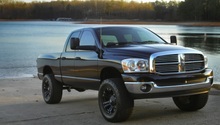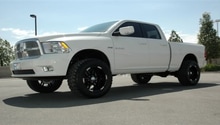Dodge Ram 1994-Present: Why is My Frame Squeaking?
Is your Dodge Ram's frame making annoying squeaky sounds? This article will help you locate the source of the problem and make your ride nice and quiet again.
This article applies to the Dodge Ram 1500 (1994-Present).
A squeaky frame isn't just a major annoyance, it can also be an indication of a potential problem or perhaps a future one. The source of your squeak generally comes from worn suspension components, but where do you begin trying to figure out which one? Keep reading and we'll run down the potential culprits and help get you rolling smoothly and quietly down the highway once again.

Materials Needed
- Floor jack
- Jack stands
- Pry bar (optional)
Step 1 – Check your bushings
One of the most common causes of a squeaky suspension is bad or worn suspension bushings. Bad bushings typically make clunking, squealing, and squeaking noises while driving over various surfaces. You may also hear a heavy clunk when turning the steering wheel, or feel the vehicle drift to one side of the road while driving on a straight road. Look for abnormal wear on your tires and examine all of your suspension bushings for damage or wear. You will find bushings on your sway bar, shocks or struts, and control arms. Replace any bushings that are damaged, worn, or crushed in appearance.

If your bushings look fine then proceed on to Step 2.
Step 2 – Check your ball joints
Bad ball joints can cause a disconnected, wandering feeling in the steering, or a pull to one side. Loud banging and popping noises can occur, or even a slight tap when the wheel is turned. Generally, the noise starts out fairly quiet and subdued and gets louder as time progresses. Ball joints can also cause tires to wear unevenly. To check your ball joints, jack up the vehicle until the wheels are hanging freely. Grab one tire at the top and bottom, and try to pull and push in an alternating manner, top to bottom and side to side. If the tire moves around a lot or makes noises while doing so, you likely have a bad ball joint.

Related Articles
- How to Jack up Your Car - DodgeForum.com
- Dodge Ram 1994-2001: How to Replace Ball Joints - DodgeForum.com
- Dodge Ram 2002-Present: How to Replace Ball Joints - DodgeForum.com
If the ball joints look great then proceed to Step 3.
Step 3 – Check your tie rods
Bad tie rod ends can cause the steering wheel to shake, especially when turning. As the problem progresses, you will notice a lot of vibration while driving, also the tires will start to move and shake on their own. They also cause your tires to "toe out," which results in the inside of the tire tread to wear faster than the outside. To check your tie rods, jack up and suspend the vehicle so the front tires are hanging freely. Push in and out on the front of the tires to see if they are loose. Any play here indicates a bad tie rod.

If there is no play in the tires then continue to Step 4.
Step 4 – Check your shocks
When shocks begin to wear out, they will start to squeak when you drive over bumps and uneven road surfaces. You will also notice a decrease in handling and ride quality, as well as a "bouncy" feeling when driving over uneven surfaces. To check your shocks, push down on each corner of the truck above each wheel and let go, if the truck bounces once or multiple times, your shocks are worn and should be replaced.

Related Articles
- Dodge Ram 1994- 2001: How to Replace Shocks - DodgeForum.com
- Dodge Ram 2002-2008: How to Replace Shocks - DodgeForum.com
- Dodge Ram 2009-Present: How to Replace Shocks - DodgeForum.com
Related Discussions
- Squeaking Noise - DodgeForum.com
- Creaking Sound When Going Over Bumps - DodgeForum.com
- Squeaky Front Driver's Side - DodgeForum.com






